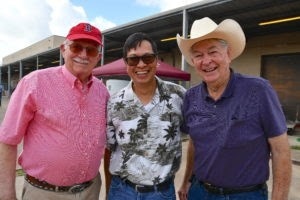Sep 8 2017
According to Researchers finding sustainable markets for wood chips, gin trash and other waste products could be viable in creating additional electrical power for a growing global population.
 Credit: Texas A&M AgriLife
Credit: Texas A&M AgriLife
Recently at Texas A&M University in College Station, a demonstration showed how a biomass-fueled fluidized bed gasifier utilized wood chips and cotton gin trash to power an electric generator. The fluidized bed gasification system was formed in the 1980s when a patent was granted to Dr.s Calvin Parnell Jr. and W.A. Lepori, who were both part of the Texas Agricultural Experiment Station now Texas A&M AgriLife Research.
Cotton gin trash and other biomass feedstocks have been utilized as fuel to produce heat energy for power production. The technology has been a central point for Dr. Sergio Capareda, a Texas A&M AgriLife Research Agricultural Engineer in the department of Biological and Agricultural Engineering at Texas A&M, who studied the technology while doing his graduate degree during the late 1980s. LePori and Parnell were Capareda’s graduate advisors.
Cotton gin trash is generated a lot at cotton gins throughout Texas and typically not used for anything, Capareda said. During harvest season, piles of cotton gin trash can be found at gins across the state.
The process is gasification. We limit the amount of air to thermally convert the biomass so the products are combustible gases. These are collectively called synthesis gas. Carbon monoxide and hydrogen, plus a little methane, ethlyene, these are a combustible mixture. Combustible in a sense that you can feed it into an internal combustible engine coupled with a generator so you can turn this fuel into electrical power.
Dr. Sergio Capareda, a AgriLife Research Agricultural Engineer, the department of Biological and Agricultural Engineering, Texas A&M University
“It’s easier said than done, because you have to remove the biochar and all the tar in the syngas before it goes into the engine. We have cleaned up the gas very well in this technology.” Dr. Capareda added.
The technology changes biomass into electrical power, making it an appealing opportunity for electric utilities and the processing industry.
For this particular demonstration, we used the conversion of cotton gin trash into electrical power. We also used wood waste and turned it into electrical power. With the price of electrical power at 10 cents per kilowatt-hour, the economics are very simple. If you run a 1 megawatt system and sell power for 10 cents per kilowatt an hour, your gross revenue is $1 million. If you find some countries overseas where power is very high, this technology is very attractive.
Dr. Sergio Capareda, a AgriLife Research Agricultural Engineer, the department of Biological and Agricultural Engineering, Texas A&M University
Capareda said the biomass used in the system has to be reliable, meaning whether wood chips or cotton gin trash are being used, it has to be fairly dry and clean without rocks, soil or metals.
“That’s how you begin, make sure it is dry and consistent,” he said. “Then you can run this system 24/7. We need 1.5-2 tons per hour or about 36 tons a day to generate 1 megawatt depending on the type of biomass. High-energy content biomass would need a little less than that. It also depends on heating value and moisture content of biomass.”
(This technology) has taken a very evolutionary approach going from a very basic system to one that is computerized. We’re very excited about it and think it has some good applications. We have a number of very big companies interested in this intellectual property.
Bob Avant, Director of Corporate Relations, AgriLife Research
Gasification Research